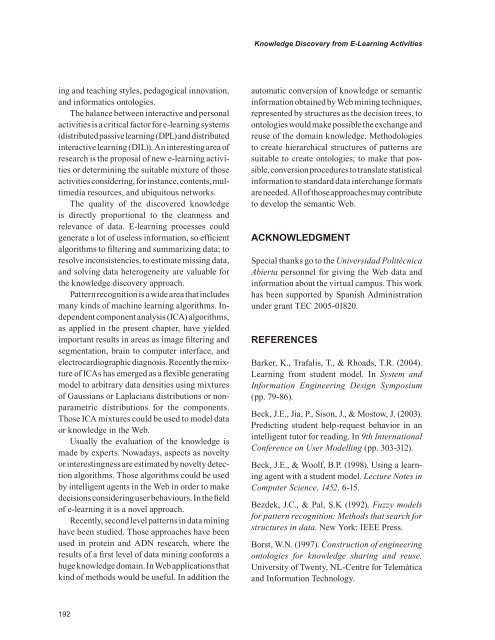Advances in E-learning-Experiences and Methodologies
Create successful ePaper yourself
Turn your PDF publications into a flip-book with our unique Google optimized e-Paper software.
Knowledge Discovery from E-Learn<strong>in</strong>g Activities<br />
<strong>in</strong>g <strong>and</strong> teach<strong>in</strong>g styles, pedagogical <strong>in</strong>novation,<br />
<strong>and</strong> <strong>in</strong>formatics ontologies.<br />
The balance between <strong>in</strong>teractive <strong>and</strong> personal<br />
activities is a critical factor for e-learn<strong>in</strong>g systems<br />
(distributed passive learn<strong>in</strong>g (DPL) <strong>and</strong> distributed<br />
<strong>in</strong>teractive learn<strong>in</strong>g (DIL)). An <strong>in</strong>terest<strong>in</strong>g area of<br />
research is the proposal of new e-learn<strong>in</strong>g activities<br />
or determ<strong>in</strong><strong>in</strong>g the suitable mixture of those<br />
activities consider<strong>in</strong>g, for <strong>in</strong>stance, contents, multimedia<br />
resources, <strong>and</strong> ubiquitous networks.<br />
The quality of the discovered knowledge<br />
is directly proportional to the cleanness <strong>and</strong><br />
relevance of data. E-learn<strong>in</strong>g processes could<br />
generate a lot of useless <strong>in</strong>formation, so efficient<br />
algorithms to filter<strong>in</strong>g <strong>and</strong> summariz<strong>in</strong>g data; to<br />
resolve <strong>in</strong>consistencies, to estimate miss<strong>in</strong>g data,<br />
<strong>and</strong> solv<strong>in</strong>g data heterogeneity are valuable for<br />
the knowledge discovery approach.<br />
Pattern recognition is a wide area that <strong>in</strong>cludes<br />
many k<strong>in</strong>ds of mach<strong>in</strong>e learn<strong>in</strong>g algorithms. Independent<br />
component analysis (ICA) algorithms,<br />
as applied <strong>in</strong> the present chapter, have yielded<br />
important results <strong>in</strong> areas as image filter<strong>in</strong>g <strong>and</strong><br />
segmentation, bra<strong>in</strong> to computer <strong>in</strong>terface, <strong>and</strong><br />
electrocardiographic diagnosis. Recently the mixture<br />
of ICAs has emerged as a flexible generat<strong>in</strong>g<br />
model to arbitrary data densities us<strong>in</strong>g mixtures<br />
of Gaussians or Laplacians distributions or nonparametric<br />
distributions for the components.<br />
Those ICA mixtures could be used to model data<br />
or knowledge <strong>in</strong> the Web.<br />
Usually the evaluation of the knowledge is<br />
made by experts. Nowadays, aspects as novelty<br />
or <strong>in</strong>terest<strong>in</strong>gness are estimated by novelty detection<br />
algorithms. Those algorithms could be used<br />
by <strong>in</strong>telligent agents <strong>in</strong> the Web <strong>in</strong> order to make<br />
decisions consider<strong>in</strong>g user behaviours. In the field<br />
of e-learn<strong>in</strong>g it is a novel approach.<br />
Recently, second level patterns <strong>in</strong> data m<strong>in</strong><strong>in</strong>g<br />
have been studied. Those approaches have been<br />
used <strong>in</strong> prote<strong>in</strong> <strong>and</strong> ADN research, where the<br />
results of a first level of data m<strong>in</strong><strong>in</strong>g conforms a<br />
huge knowledge doma<strong>in</strong>. In Web applications that<br />
k<strong>in</strong>d of methods would be useful. In addition the<br />
automatic conversion of knowledge or semantic<br />
<strong>in</strong>formation obta<strong>in</strong>ed by Web m<strong>in</strong><strong>in</strong>g techniques,<br />
represented by structures as the decision trees, to<br />
ontologies would make possible the exchange <strong>and</strong><br />
reuse of the doma<strong>in</strong> knowledge. <strong>Methodologies</strong><br />
to create hierarchical structures of patterns are<br />
suitable to create ontologies; to make that possible,<br />
conversion procedures to translate statistical<br />
<strong>in</strong>formation to st<strong>and</strong>ard data <strong>in</strong>terchange formats<br />
are needed. All of those approaches may contribute<br />
to develop the semantic Web.<br />
AcknowLedgment<br />
Special thanks go to the Universidad Politécnica<br />
Abierta personnel for giv<strong>in</strong>g the Web data <strong>and</strong><br />
<strong>in</strong>formation about the virtual campus. This work<br />
has been supported by Spanish Adm<strong>in</strong>istration<br />
under grant TEC 2005-01820.<br />
reFerences<br />
Barker, K., Trafalis, T., & Rhoads, T.R. (2004).<br />
Learn<strong>in</strong>g from student model. In System <strong>and</strong><br />
Information Eng<strong>in</strong>eer<strong>in</strong>g Design Symposium<br />
(pp. 79-86).<br />
Beck, J.E., Jia, P., Sison, J., & Mostow, J. (2003).<br />
Predict<strong>in</strong>g student help-request behavior <strong>in</strong> an<br />
<strong>in</strong>telligent tutor for read<strong>in</strong>g. In 9th International<br />
Conference on User Modell<strong>in</strong>g (pp. 303-312).<br />
Beck, J.E., & Woolf, B.P. (1998). Us<strong>in</strong>g a learn<strong>in</strong>g<br />
agent with a student model. Lecture Notes <strong>in</strong><br />
Computer Science, 1452, 6-15.<br />
Bezdek, J.C., & Pal, S.K (1992). Fuzzy models<br />
for pattern recognition: Methods that search for<br />
structures <strong>in</strong> data. New York: IEEE Press.<br />
Borst, W.N. (1997). Construction of eng<strong>in</strong>eer<strong>in</strong>g<br />
ontologies for knowledge shar<strong>in</strong>g <strong>and</strong> reuse.<br />
University of Twenty, NL-Centre for Telemática<br />
<strong>and</strong> Information Technology.


